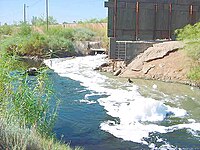
Photo from wikipedia
Comprehensive enrichment of contaminants in drinking water is an essential step for accurately determining exposure levels of contaminants and testing their biological effects. Traditional methods using a single absorbent for… Click to show full abstract
Comprehensive enrichment of contaminants in drinking water is an essential step for accurately determining exposure levels of contaminants and testing their biological effects. Traditional methods using a single absorbent for enriching contaminants in water might not be adequate for complicated matrices with different physical-chemical profiles. To examine this hypothesis, we used an integrated enrichment system that had three sequential stages-XAD-2 resin, poly (styrene-divinylbenzene) and activated charcoal to capture organic pollutants and disinfection by-products (DBPs) from drinking water in Shanghai. Un-adsorbed Organic Compounds in Eluates (UOCEs) named UOCEs-A, -B, and-C following each adsorption stage were determined by gas chromatography-mass spectrometry to evaluate adsorption efficiency of the enrichment system. Meanwhile, biological effects such as cytotoxicity, effects on reactive oxygen species (ROS) generation and glutathione (GSH) depletion were determined in human LO2 cells to identify potential adverse effects on exposure to low dose contaminants. We found that poly-styrene-divinylbenzene (PS-DVB) and activated charcoal (AC) could still partly collect UOCEs-A and-B that the upper adsorption column incompletely captured, and that potential carcinogens like 2-naphthamine were present in all eluates. UOCEs-A at (1-4000), UOCEs-B at (1000-4000), and UOCEs-C at (2400-4000) folds of the actual concentrations had significant cytotoxicity to LO2 cells. Additionally, ROS and GSH change in cells treated with UOCEs indicated the potential for long-term effects of exposure to some mixtures of contaminants such as DBPs at low doses. These results suggested that an enriching system with a single adsorbent would underestimate the exposure level of pollutants and the biological effects of organic pollutants from drinking water. Effective methods for pollutants' enrichment and capture of drinking water should be given priority in future studies on accurate evaluation of biological effects exposed to mixed pollutants via drinking water.
Journal Title: Chemosphere
Year Published: 2022
Link to full text (if available)
Share on Social Media: Sign Up to like & get
recommendations!